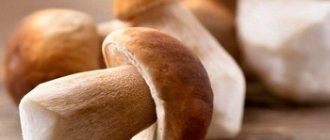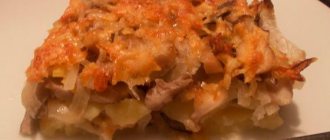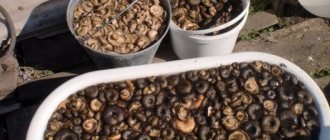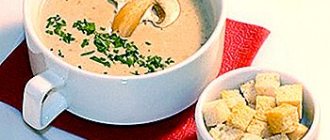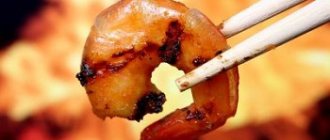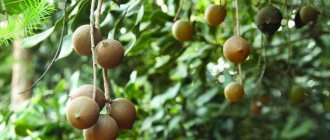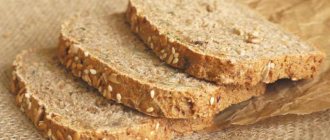Calorie content of fried chanterelles per 100 grams
Calorie content of fried chanterelles with sour cream per 100 grams is 72 kcal. In a 100-gram serving of these mushrooms:
- 1.8 g protein;
- 6.1 g fat;
- 3.3 g carbohydrates.
Read: Calorie content of cherry plum marshmallow
To prepare fried chanterelles you need:
- rinse well, peel and cut 0.5 kg of mushrooms into medium-sized pieces;
- pour the chopped chanterelles into a frying pan, add water so that the liquid covers only a third of the height of the mushrooms;
- add salt to taste;
- Bring the chanterelles to a boil under a closed lid and boil for 10 minutes. After this, remove the lid and simmer the mushrooms for another 8 minutes. The indicator of readiness of mushrooms is almost all the water has evaporated;
- While cooking the chanterelles, finely chop and fry 100 g of onion in vegetable oil;
- pour the frying into a frying pan with boiled chanterelles, add vegetable oil and fry the mushrooms for 6 - 10 minutes with constant stirring;
- reduce the heat, add 140 g of 15% sour cream to the mushrooms, mix all the ingredients of the dish;
- Chanterelles are stewed with sour cream under a closed lid for 5 minutes.
Application
Chanterelle does not lose its excellent taste when pickling, salting, frying and drying.
When marinating chanterelles, the color of the mushroom does not change, but the marinade darkens a little. This method perfectly preserves the mushroom for a long time.
Before cooking, peeled chanterelles should be soaked in milk for about two hours, and professional chefs advise even boiling them a little. When cooking, lemon juice will help preserve the golden color of the mushroom.
The mushroom almost never acts as an independent dish, but it serves as a component in a huge number of dishes. Particularly appreciated is the sauce made from fresh or pickled chanterelles, which goes perfectly with pasta, meat or vegetable dishes.
Market Analytics
- COVID-19 is changing the rules of the game in the cosmetics market
- Beauty of the future: cosmetic innovations 2020
- New ingredients are the driving force of the cosmetics industry
Convenient search for beauty salons on our website
Beauty salons in Moscow Beauty salons in St. Petersburg Beauty salons in Ekaterinburg Beauty salons in Novosibirsk
Latest blog posts on our website
- Naturecream / Geranium (Pelargonium) oil for skin health and beauty
- Prostye-sovety / Save on a beauty salon: procedures that can be done at home
- Naturecream / Growth Factor - brings back youth?
- Oksana-Lezina / 3 effective abdominal exercises from a fitness instructor for beginners
- Prostye-sovety / Making perfect curls at home
- Prostye-sovety / Which hair removal method to choose
- Naturecream / Wrinkles Puppets
- Naturecream / PEPHA-TIGHT - instant skin lifting
- Naturecream / Blue light - a danger to the skin
- Naturecream / Cocoa Butter – A treat for the skin
Latest forum topics on our website
- Mrs._Smith / Badly sunburned! What to do?((
- Ice / Is it necessary to combine fitness classes with a diet?
- Antonova / What can be used for hair loss?
- Radio operatorKat / Who was on a protein diet?
- Suzanna / Mesotherapy on the face
Other articles in this section
| Dried boletus Boletus is the most common type of edible mushroom. In total, 12 species of edible boletus are known. The mushroom can be found in deciduous or mixed light forests, where birch trees are predominantly found. Boletuses are found in Eurasia, the forests of North and South America, as well as in the tundra where dwarf birches grow. Mushrooms begin to grow from early summer until late autumn. Boletus mushrooms cannot be found in dense forests, because the main condition for their productivity is the abundance of sunlight. |
| Champignons "Champignon" means mushroom in French. This is one of the most famous and widespread mushrooms in the world. It is great to grow at home or on mushroom farms. Mentions of the first cultivation of champignons go back more than 1000 years. The French were the first to grow these mushrooms, and they gave them the name “Parisian mushroom”. At the same time, around the 17th century, it was noticed that mushrooms love dampness, warmth and soft light. Currently, champignon cultivation is fully automated. Previously, they were considered food for select, high-ranking people, such as monarchs. |
| Puffballs The puffball mushroom can be found in deciduous and coniferous forests, sometimes on rotting wood or on the soil. The mushroom has a closed, rounded fruiting body up to 8 cm in diameter, with a pseudopod up to 3 cm thick. The skin of the puffball is covered with small pearl-like growths that fall off when ripe. Young specimens have a uniform consistency, bright white skin and pulp, which changes to gray and then brownish-brown as the mushroom ages. Mature mushrooms become inedible; secrete brown-brown spores through the apex; their flesh is less elastic than the flesh of young mushrooms. |
| White pickled White mushroom is so called due to its property of not changing color when cooked. Since ancient times, this mushroom has been considered noble; it is called the “king of mushrooms.” The porcini mushroom grows in old pine and spruce (for this it is also called boletus), oak and birch forests. Very common in Russian forests. It grows singly and in groups from the second half of July until late autumn. |
| Shiitake Shiitake is a tree mushroom that is sold and grown in many countries, but is native to Japan and China. There, mushroom cultivation began more than a thousand years ago, around 199 BC. Mushrooms are incredibly aromatic and tasty. The taste of shiitake is a cross between champignons and porcini mushrooms. The shape of the cap also resembles a champignon, only the color is light or dark brown. |
| Oyster mushrooms Oyster mushrooms are a common, accessible and inexpensive product. They grow on trees and stumps, grown on straw and sawdust thanks to modern technologies for their production, which were developed by German mushroom growers during the First World War. This mushroom can be grown fairly quickly and is also easy to process. This mushroom is easy to grow at home. The surface of the mushroom cap is smooth, wavy, and various shades of gray. |
| White dried White mushrooms belong to the boletus genus. They gained wide popularity due to their unique taste qualities, which are definitely superior to all other edible mushrooms. Why this species is called “white” is unknown, but already in the dictionary of V.I. Dalia mushroom has this name. When storing dried porcini mushrooms, it is worth considering that they perfectly absorb moisture, so the premises for storing them must be clean, dry, with constant air circulation and without sudden temperature changes. |
| Russula Russula is widely found throughout Russia and belongs to the family of lamellar mushrooms. It has a wide flat cap, at the bottom of which there are yellowish or white plates. Attention!! Under no circumstances should the plates of the mushroom be black, red or brown, in which case it is not a russula, but a poisonous mushroom! The russula stem is the same along its entire length, without a tuber at the end and a “skirt”. The growing areas of the mushroom are very extensive - it can be either open shady meadows or sparse undergrowth. Most often, russula can be found near young birch trees or along the side of country roads. |
| Gruzdi The word “gruzd”, as you know, comes from the Old Slavonic word “gruzdie” (heap). This mushroom is called so because it grows in heaps and families. According to another version, it received this name for its massiveness and heaviness. The milk mushroom belongs to the Syroezhkov family. Grows in deciduous and mixed forests. It is common in central Europe and Asia. However, in Western European countries it is almost unknown and is considered inedible. At the same time, in Russia, especially in Siberia, it has long been considered the best for pickling. Milk mushrooms contain caustic juice in their pulp, which loses its causticity when processed. They have a strong specific smell. The time for collecting milk mushrooms is August, September. |
| Dried Shiitake Shiitake (Lentinula edodes in Latin) is known as an edible mushroom. Europeans gave it the name “Chinese black mushroom”. It grows on trees or stumps, most often on the Castanopsis long-pointed tree. The mushroom has a dark brown lamellar cap, with a diameter of 5 cm to 20 cm and a fibrous stalk. The historical homeland of mushrooms is Japan and China; there is evidence that already in 199 AD they were eaten, but mushrooms appeared in folk medicine much earlier. |
Calorie content of boiled chanterelles per 100 grams
The calorie content of boiled chanterelles per 100 grams is 32 kcal. In 100 g of mushrooms:
- 2.61 g protein;
- 1.94 g fat;
- 1.76 g carbohydrates.
Read: Calorie content of frozen sea buckthorn
The vitamin and mineral composition of boiled chanterelles is represented by vitamins A, B1, B2, E, C, PP, minerals magnesium, calcium, phosphorus, potassium, zinc, iron, chlorine, manganese, copper, fluorine, cobalt.
Useful properties of chanterelles
Chanterelle is rich in vitamins, amino acids, and microelements that help improve vision, namely cure night blindness.
Phosphorus and calcium in its composition are important components of bone health and growth. That is why the product will be useful for children as they grow, and for pregnant women for the formation of the musculoskeletal system of the fetus.
Trametonolinic acid in chanterelles can fight hepatitis viruses. The K-10 polysaccharide in chanterelles also has a negative effect on them. These mushrooms improve the condition of the mucous membranes of the eyes, moisturizing them and making them more resistant to infections.
It should be noted that in Europe, hepatitis and other liver diseases are treated with extracts from chanterelles.
Since ancient times in Rus', boils and sore throats were treated with an infusion of them. Another useful property of these mushrooms is that they inhibit the proliferation of tuberculosis bacillus.
The most delicious are fried chanterelles, which go well with potatoes and rice. Considering the low calorie content of these mushrooms, the low fat content in the composition, their moderate consumption cannot harm the figure.
Along with its beneficial properties, this product also has its own characteristics of use. So, some people may experience individual intolerance to these mushrooms. Their use is also contraindicated for children of preschool age.
Calorie content of salted chanterelles per 100 grams
The calorie content of salted chanterelles per 100 grams is 19.6 kcal. In 100 g of mushrooms:
- 1.54 g protein;
- 1.12 g fat;
- 1.32 g carbohydrates.
Read: Calorie content of rowan per 100 grams
Salted chanterelles are contraindicated for peptic ulcers of the stomach and intestines, and a tendency to edema. Such mushrooms should be avoided in case of gastritis, inflammatory processes of the pancreas and gall bladder.
How to cook chanterelles?
Chanterelle dishes are very tasty. Mushrooms must be cooked properly, otherwise the bitter taste will remain. Before cooking, they must be soaked in clean water; you can also boil mushrooms in milk. These techniques enhance the extraordinary taste of the mushrooms, and the texture of the product becomes soft, but the shape is not lost.
By the way, the color of mushrooms does not change during cooking; in the marinade, for example, the color becomes brown, but basically the bright color is retained. Chanterelles are great for preparing various dishes - soups, sauces, salads, and simply as an independent dish.
If you don’t know where to pick and what mushrooms look like, it’s better to turn to industrial manufacturers, buying a ready-made product.
The benefits of chanterelles
The beneficial properties of chanterelles include:
- mushrooms are enriched with natural polysaccharides, which are actively used for the production of medicines for worms;
- infusions based on chanterelles are used to treat abscesses and sore throats;
- due to the saturation of mushrooms with carotene, they are indicated for improving the condition of the mucous membranes of the eyes;
- Regular consumption of chanterelles ensures cleansing of the body from heavy metal salts;
- mushrooms contain vitamin A, which strengthens the immune system and has a beneficial effect on the condition of the skin, nails, and hair;
- Chanterelle acids are useful for normalizing liver functions, accelerating the process of liver recovery in case of hepatitis;
- In folk medicine, chanterelles are famous as a natural antibiotic. Such mushrooms slow down the development of tuberculosis bacillus.
Damage to chanterelles
Chanterelles are considered contraindications for consumption.
“Silent hunting”, or mushroom hunting, is a favorite pastime of Russians, a good opportunity to be alone with nature, breathe fresh air and gain strength, while receiving a good bonus in the form of beautiful and fragrant mushrooms. There are many varieties, and in each region certain types of mushrooms predominate, but there are also those that can be found everywhere. Among them are chanterelles, finding which is the cherished dream of every mushroom picker. Before you count how many calories are in chanterelle mushrooms and understand whether they can be used in dietary nutrition, you should know that in addition to several subspecies of the mushroom, there is a false chanterelle, or orange talker, a poisonous mushroom that is not related to the chanterelle genus. First of all, remember that chanterelles do not grow on stumps and tree trunks, the color of the chanterelle is lighter, the edges of the cap are wavy, and there are other distinctive features.

